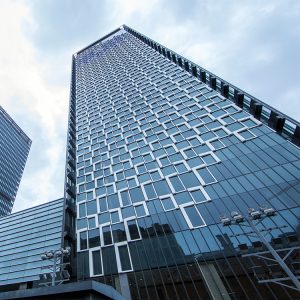Performance of fire rated curtain wall in applications
Today, curtain walls, the most common cladding for high rise buildings, have evolved in a variety of applications and present varying conditions at the slab edge. In general, the control of fire spread in a high rise building depends on a number of active and passive measures. Fire spread control at the perimeter slab edge involves an interaction of wall, floor and connecting fire stop materials.

In practical applications, glass or metal curtain walls used on high rise buildings are typically not fire rated assemblies. It is difficult to imagine a
non-rated wall assembly holding traditional mineral wool fire stop in place for the 1 or 2 hours required by the floor rating. This however is precisely the expectation inherent in most current wall construction. Furthermore, if a fire were to break out in a high-rise building, the spread of fire would be vertical – going from one floor to the next, following with the flow of air currents. This is because the void between the floor and curtain wall are not properly sealed. The fire will affect both sides of the curtain wall system causing premature failure of the wall and potentially the vision glass. In that regard, fire-rated curtain wall becomes popular in the modern tall buildings in recent years. For those considering using fire-rated glazing systems to create design-forward assemblies worthy of such praise, the path to safe and successful installations would not be daunting.
For a long time, glass curtain wall systems are not only beautiful, but also functional, allowing in natural light and increasing energy efficiency. Glass curtain wall systems are widely used in commercial buildings for a long time, for they can provide added structural stability for tall structures and can also reduce sway and protect against high winds and geological events. In practical applications, fire-rated curtain wall systems can provide a substantial area of glazing both in interior and exterior locations while defending against the transfer of flames, smoke, radiant and conductive heat. Fire-rated curtain wall systems also employ fire resistive-rated framing materials. In recent years, in order to achieve the necessary defense, fire-rated curtain wall systems will use transparent glass wall panels of significant heat-blocking capabilities. Particularly, more and more curtain wall manufacturers try to use different methods to ensure these high-performance products pass the necessary fire tests and remain relatively cool on the non-fire side of the glass curtain walls for the duration of their designated fire rating.
Tel: +86 18202256900 Email: steel@tjdpbd.com









